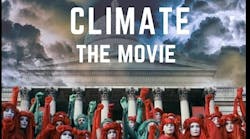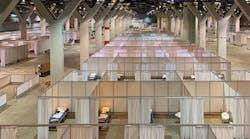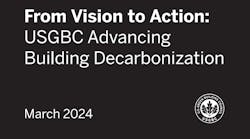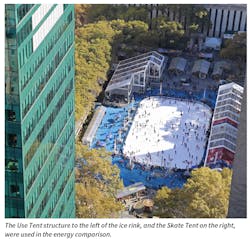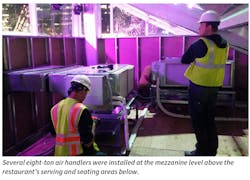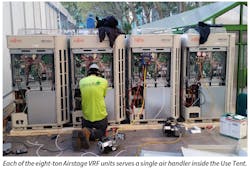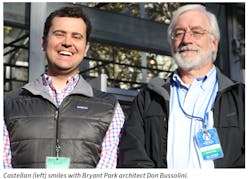By RACHEL RUHL, Common Ground
When parks in the Big Apple come up in conversation, most people think of Central Park. While it is one of the most-visited urban parks in the U.S., it’s far from the largest park in Manhattan. New York City has 28,000 acres of municipal parkland.
Though not huge by any means, Bryant Park, in midtown Manhattan, distinguishes itself by offering the city’s only free ice skating rink and a traditional German holiday market throughout each winter. Quaint little shops spring up on the walkways that surround the skating rink, offering all variety of gifts.
“It’s called Bank of America Winter Village,” said Matt Castellan, brand relations manager at Bryant Park. “Since Winter Village began in 2003, attendance has grown steadily. The ice rink was added in 2005, and roughly four million visitors came to the attraction last year.”
In addition to the holiday shops, gourmet food is offered by Public Fare, a restaurant covered by a large Plexiglas structure in the northeast corner of the park. This temporary Use Tent, along with a very similar structure on the other side of the ice rink called the Skate Tent, became the proving grounds for a head-to-head heating system comparison this past holiday season.
“The 2016/2017 season was the first year we took management of behind-the-scenes elements in-house,” explained Castellan. HVAC is one of those elements. In years past, it has cost roughly $400,000 dollars to heat the combined 15,000 sq ft of indoor space while Winter Village was in operation.
“Last year we decided to make a change in order to gain control of the energy costs, and hopefully improve comfort levels in the tents,” he added.
Side-by-side comparison
In early 2016, after consulting with several mechanical firms regarding alternatives to heating the temporary structures, Bryant Park management chose to hire Green Star Energy Solutions, which suggested the use of VRF heat pumps.
Green Star provides what it calls “holistic efficiency,” where cutting-edge heating and cooling technologies are paired with building envelope improvements. The company serves the greater NYC metro area.
“Because the design considerations on this project were so unusual, we wanted to be sure we had ample support from the manufacturer,” said Tom Esposito, director of business development at Green Star.
“Brendan Casey, Fujitsu’s New York City Sales Engineer, has always been a great ally through design, commissioning and service of Airstage VRF systems we’ve installed in the past,” continued Esposito. “Brendan already knew what Bryant Park was looking to accomplish when we approached him with it.”
But Green Star wanted to up the ante by monitoring and comparing the energy use of the Aggreko electric resistance and VRF systems. In order to ensure accurate results, Steven Winter Associates, Inc. (SWA), offered to conduct testing.
SWA’s key focus is energy auditing, commissioning and LEED certification. With offices in NY, CT and Washington DC, SWA has worked on numerous retro-commissioning projects with Green Star in the past.
The 5,000-sq-ft, rink-side eatery, Public Fare, was soon to be conditioned by four, eight-ton Airstage VRF systems with backup heat elements. This building has double-height walls and is divided into two distinct areas. The Table Side includes restaurant seating and a coffee bar, while the Open Side has a few tables spread out over a larger area, making it a great rentable space for events.
Condensing units are located behind the tent. Each one provides capacity to a single, eight-ton air handler located at the mezzanine level above the serving and seating areas below.
On the other side of the ice rink, the Skate Tent is of similar construction, though larger, at 10,000 sq ft. For purposes of analysis, the Skate Tent was used as the control location or group, and the structure was divided into four distinct sections, each with its own 100 kW electric heater. The rec room and the office are both on the second level with single height walls and vaulted ceilings. The skate rental area and baggage counter are both at ground level with double height walls.
The resistance heaters were fan coils with flexible ductwork. Warm air is delivered to the space through vents approximately 20 feet above floor level.
Measurement and verification
“This project wasn’t unconventional, but it’s not our bread and butter, either,” said Michael Flatley, director of commercial building energy services at SWA.
“We do all sorts of product testing, and M&V (measurement and verification) is a big part of what we do,” added Flatley. “This was the first temporary, tented application we’ve come across.”
SWA installed HOBO data loggers to continuously collect information at five-minute intervals from December 23, 2016 through March 5, 2017. This included local weather data (dry bulb, dew point and relative humidity), space conditions and equipment amperage. Space conditions (temperature and relative humidity) were measured at numerous locations throughout the Skate and Use tents.
Amperage measurements were combined with one-time measurements of voltage to determine power consumption. These voltage measurements were taken during the installation of the amperage metering equipment.
Each of the VRF indoor, outdoor and backup elements were individually monitored, as were each of the four electric heaters in the Skate Tent. Both comfort levels and energy efficiency were compared.
“The biggest challenge was locating the sensing devices,” explained Flatley.
“With the temporary nature of the buildings, and the constant risk of tampering, we had to get pretty creative. And it didn’t help that there was solar gain all throughout the structures, especially on higher walls.”
Curious findings
Two anomalies were immediately noticed after analyzing the collected data. Contacts on the data logger that served the baggage counter in the Skate Tent were found unplugged toward the end of the testing period. As such, the information from this logger was discarded.
In the Use Tent, two of the four data loggers connected to the Fujitsu backup heaters were nowhere near consistent with the other two backup units. They provided energy consumption results much lower than the other two. This could have been caused by any number of logger issues, so this data was removed from the remaining analyses and omitted from the average performance curve.
Based on the information collected, both systems appeared to be undersized for the load experienced within the space. However, several further conclusions may be drawn about the performance of electric resistance heaters versus VRF heat pumps.
For each of the Aggreko heaters, power consumption leveled off at temperatures lower than the typical design conditions for NYC, which is 8°F. Similarly, the controls for the backup heaters on the VRF systems were set up to limit operation while the heat pumps had available capacity. But the data shows that the backup heaters were activated between 40-50°F, which indicates that the Fujitsu units were nearing full capacity in that temperature range. This meant that the backup heaters in the Use Tent ran far more frequently than was intended.
When comparing the space temperature graphs, the Fujitsu VRF units are equally capable of maintaining similar space conditions with the assistance of the backup heaters. For example, if a comparison is made between the Skate Rental, Baggage Counter, and the Open Side of the Use Tent, all of which have the same ceiling height, the derived space temperature curves are very similar.
However, it should be noted that the Use Tent is maintained above 60°F until outside air temperatures drop below 30°F, while the same space temperature was reached within the Skate Tent when outside air temperatures drop below 42°F. This indicates that the Fujitsu units with the backup heaters were more capable of maintaining comfortable space conditions at lower outside air temperatures than the electric resistance heaters.
Over the course of the season, the VRF units outperformed the electric heaters by roughly 70 percent, conservatively, which is consistent with the calculated efficiency of heat pumps (average COP 3.7). But because the backup electric heaters were activated for most of the winter, the net use in the Public Fare tent was only about 30 percent better.
Room for improvement
“Because of the energy savings we’ve seen across our other VRF retrofits, we were fully expecting to find a 75 percent reduction in energy use over the electric resistance heaters,” said Esposito. “The discrepancy is two-fold, and complicated by the fact that some of the loggers weren’t working as intended.”
The fact that both systems were undersized didn’t help the performance of either, but was especially detrimental to the VRF system because the backup electric heaters greatly increased energy consumption.
Had the heat pumps been able to meet demand in colder outdoor conditions, the backup heating elements would have been utilized far less frequently, meaning that the Use Tent would have operated at significantly higher efficiency levels.
This begs the question, why were the systems so dramatically undersized?
When the structures were analyzed during the design phase, the only infiltration accounted for was the doors and the ventilation systems. Unknown to everyone involved, the Use Tent building envelope was compromised throughout the whole season, due to an unsecured fabric flap in the gap between the Plexiglas walls and roof.
On cold days, the warm air in the space would cause the tent to balloon-out, like a hot air balloon, creating a large opening between the glass walls and the plastic tent. In some sections, this opening was two to three inches on very cold days. This permitted an unaccounted-for source of cold air to enter the space. Given that this was the case for the entire building perimeter, it significantly impacted the heating load.
Additional consideration should also be made for the delivery of the heated air to the spaces. Instead of delivering warm air overhead, as it will typically rise, it is advisable to deliver the heated air at the floor so that comfortable temperatures are more easily maintained at the occupied levels.
Lessons learned
“Given less-than-expected energy performance, we’re going to analyze the performance of both systems throughout this current season,” said Esposito. “The buildings will be better sealed, the systems will be sized more accurately, conditioned air will be supplied differently, and more care will be taken to ensure that loggers aren’t tampered with. I think the results will be more dramatic.”
Green Star, SWA and Fujitsu are already working with Bryant Park to accommodate the changes needed to the Use and Skate tents. With the initial trial behind them, and its lessons well noted, all eyes turn toward the current.
“Despite the energy consumption results, the comfort improvements in the Use Tent were undeniable,” said Castellan. “The VRF units were much quieter than we expected, and for the first time ever, we had air conditioning on those really mild, sunny days. We’re looking forward to seeing what happens this winter.”
The author is a writer and account manager for Common Ground, a Manheim PA-based trade communications firm.


